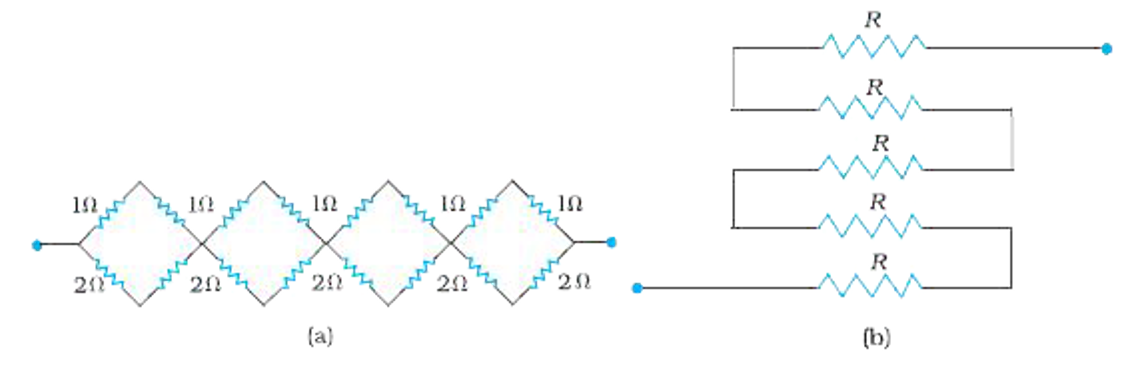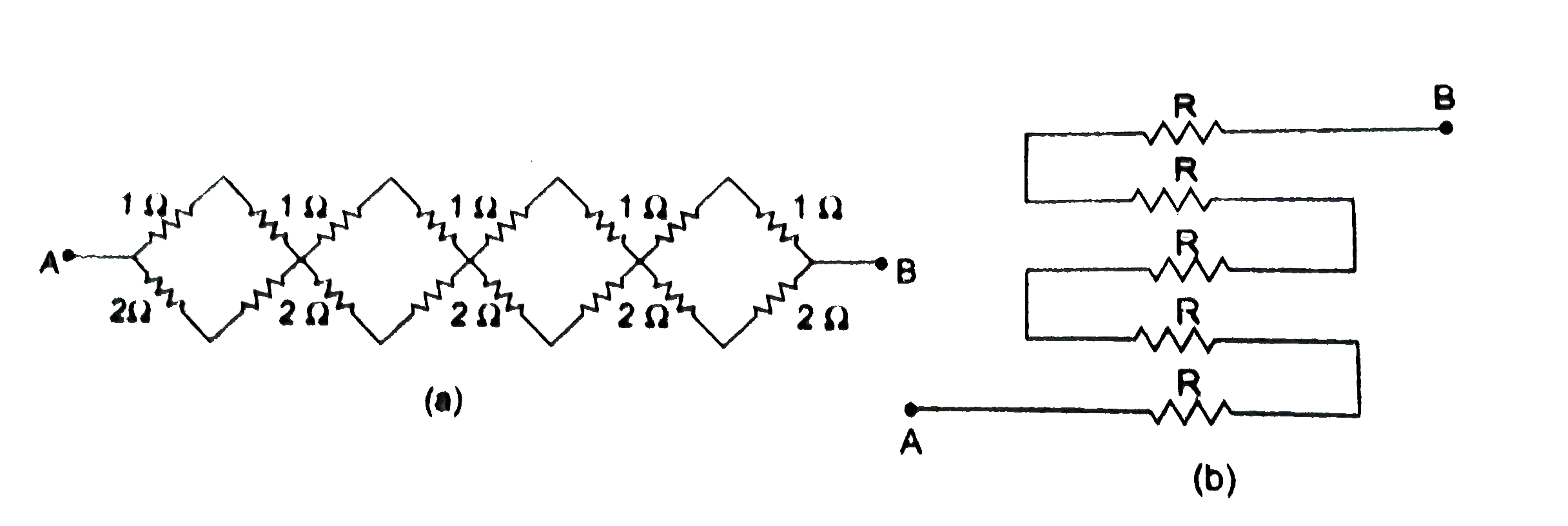(a) Given n resistores each of resistance R. how will you combine them to get the (i) maximum (ii) minimum effective resistance?
(b) Given the resistances of 1Ω,2Ω,3Ω. how will be combine them to get an equivalent resistance of (i)(11/3)Ω(ii)(11/5)Ω,(iii)6Ω,(iv)(6/11)Ω ?
(c ) Determine the equivalent resistance of networks shown in
 Solution in Tamil
Solution in Tamil
Step by step video & image solution for (a) Given n resistores each of resistance R. how will you combine them to get the (i) maximum (ii) minimum effective resistance? (b) Given the resistances of 1 Omega, 2 Omega, 3 Omega. how will be combine them to get an equivalent resistance of (i) (11//3) Omega (ii) (11//5) Omega, (iii) 6 Omega, (iv) (6//11) Omega ? (c ) Determine the equivalent resistance of networks shown in by Physics experts to help you in doubts & scoring excellent marks in Class 12 exams.
Updated on:21/07/2023Topper's Solved these Questions
- CURRENT ELECTRICITY BOOK - NCERT TAMILCHAPTER - CURRENT ELECTRICITY EXERCISE - EXERCISES
13 Videos
- COMMUNICATION SYSTEMS BOOK - NCERT TAMILCHAPTER - COMMUNICATION SYSTEMS EXERCISE - Evaluation (I. MULTIPLE CHOICE QUESTIONS)
5 Videos
- DUAL NATURE OF RADIATION AND MATTERBOOK - NCERT TAMILCHAPTER - DUAL NATURE OF RADIATION AND MATTEREXERCISE - EXERCISES
41 Videos
Similar Questions
The storage battery of a car has an emf of 12 V. If the inernal resistance of the battery of 0.4Ω, What is the maximum current that can be drawn from the battery ?
View SolutionThe output transducer of the communication system converts the radio signal into __________
View SolutionFind the (a) maximum frequency and (b) minimum wave-length of X-rays produced by 30 kV electrons. Given, h=6.63×10−34Js.
View Solution(a) Given n resistors each of resistance R . How will you combine them to get the (i) maximum (ii) minimum effective resistance ? What is the ratio of the maximum to minimum resistance ? (b) Given the resistances of 1 Omega, 2 Omega, 3 Omega , how will you combine them to get an equivalent resistance of (i) (11//3)Omega (ii) (11//5)Omega (iii) 6 Omega (iv) (6//11) Omega ? (c) Determine the equivalent resistance of networks shown in Figure.
View SolutionGiven the resistance of 1Ω,2Ω,3Ω, how will you combine them to get an e3quivalent resistance of :
113Ω (ii)115Ω (iii)6Ω 611Ω ?
View Solution(a) आपको R प्रतिरोध वाले n प्रतिरोधक दिए गए है । (i) अधिकतम (ii) न्यूनतम प्रभावी प्रतिरोध प्राप्त करने के लिए आप इन्हें किस प्रकार संयोजित करेंगे ? अधिकतम और न्यूनतम प्रतिरोधों का अनुपात क्या होगा ?
(b) यदि 1Ω,2Ω,3Ω के तीन प्रतिरोध दिए गए हों तो उनको आप किस प्रकार संयोजित करेंगे कि प्राप्त तुल्य प्रतिरोध हों : (i)(11/3)Ω,(ii)(11/5)Ω,(iii)6Ω,(iv)(6/11)Ω?
(c) चित्र 3.31 में दिखाए गए नेटवर्कों का तुल्य प्रतिरोध प्राप्त कीजिए ।

View SolutionGiven the resistances of 1 Omega, 2 Omega, 3 Omega how will be combine them to get an equivalent resistance of (i) (11/3) Omega (ii) (11/5) Omega (iii) 6 Omega (iv) (6//11) Omega
View Solutionयदि 1Ω,2Ω,3Ω के तीन प्रतिरोध दिए गए हो, तो उनको आप किस प्रकार संयोजित करेंगे की प्राप्त तुल्य प्रतिरोध हो - (i) (11/3)Ω (ii) (11/5)Ω (iii) 6Ω (iv) (6/11)Ω ?
View Solution(a) R प्रतिरोधवाले n प्रतिरोधकों को लेकर आप उन्हें किस प्रकार जोड़ेंगे ताकि तुल्य प्रतिरोध (i) महत्तम तथा (ii) न्यूनतम हो ? महत्तम तथा न्यूनतम प्रतिरोधों का अनुपात क्या होगा ?
(b) यदि 1Ω,2Ω,3Ω के तीन प्रतिरोधक दिए गए हो, तो उन्हें आप किस प्रकार संयोजित करेंगे की तुल्य प्रतिरोध के मान (i) 113Ω,(ii)115Ω,(iii)6Ω.(iv)611Ω हो ?
(c) चित्र 2.1−7 (a) और (b) में प्रदर्शित प्रतिरोधकों के संयोजक के लिए A एवं B के बीच तुल्य प्रतिरोध ज्ञात करे।

View SolutionGiven the resistances of 1Ω,2Ω,3Ω how will we combine them to get an equivalent resistance of (i) (113)Ω,(ii)(115)Ω,(iii)6Ω,(iv)(611)Ω ?
View SolutionGiven the resistances of 1Ω,2Ωand3Ω. How will you combine them to get an equivalent resistance of
(i) 113Ω ?
(ii) 115Ω ?
View SolutionGiven three resistors of resistances 1 Omega, 2Omega and 3Omega . How will you combine them to get an equivalent resistance of (11)/(5) Omega ?
View Solution(a) Given n resistores each of resistance R. how will you combine them to get the (i) maximum (ii) minimum effective resistance? (b) Given the resistances of 1 Omega, 2 Omega, 3 Omega. how will be combine them to get an equivalent resistance of (i) (11//3) Omega (ii) (11//5) Omega, (iii) 6 Omega, (iv) (6//11) Omega ? (c ) Determine the equivalent resistance of networks shown in
View Solution(a) Given n resistors each of resistance R . How will you combine them to get the (i) maximum (ii) minimum effective resistance ? What is the ratio of the maximum to minimum resistance ? (b) Given the resistances of 1 Omega, 2 Omega, 3 Omega , how will you combine them to get an equivalent resistance of (i) (11//3)Omega (ii) (11//5)Omega (iii) 6 Omega (iv) (6//11) Omega ? (c) Determine the equivalent resistance of networks shown in Figure.
View Solution(a) Given n resistores each of resistance R. how will you combine them to get the (i) maximum (ii) minimum effective resistance?
(b) Given the resistances of 1Ω,2Ω,3Ω. how will be combine them to get an equivalent resistance of (i)(11/3)Ω(ii)(11/5)Ω,(iii)6Ω,(iv)(6/11)Ω ?
(c ) Determine the equivalent resistance of networks shown in

View Solution
